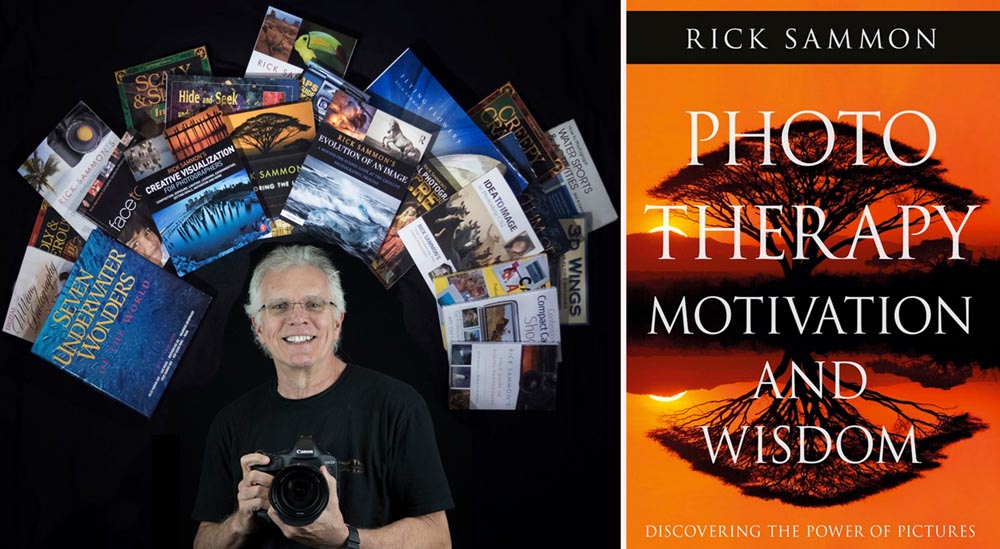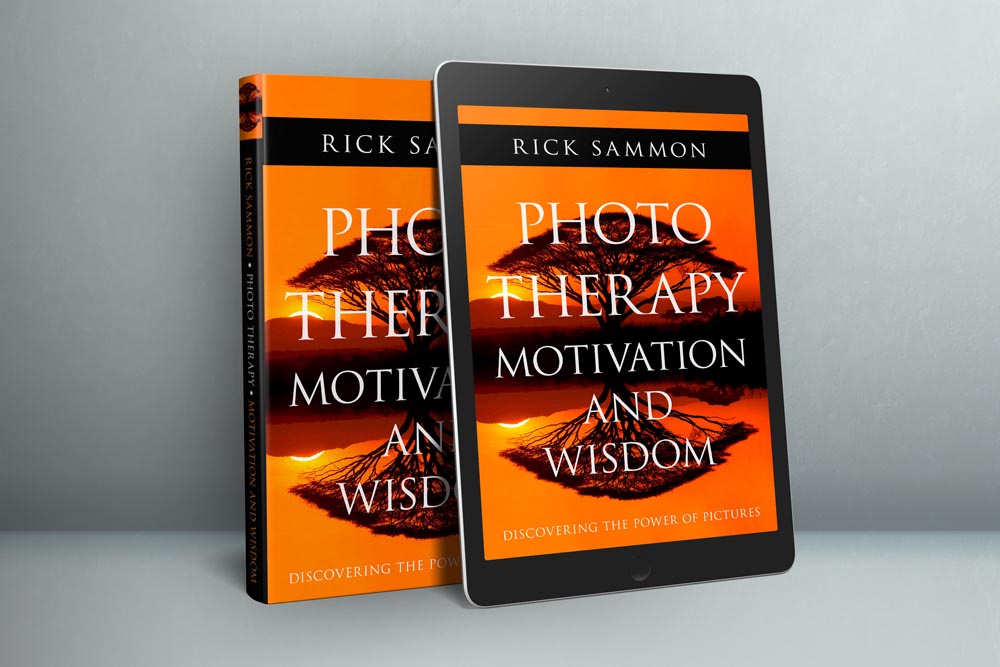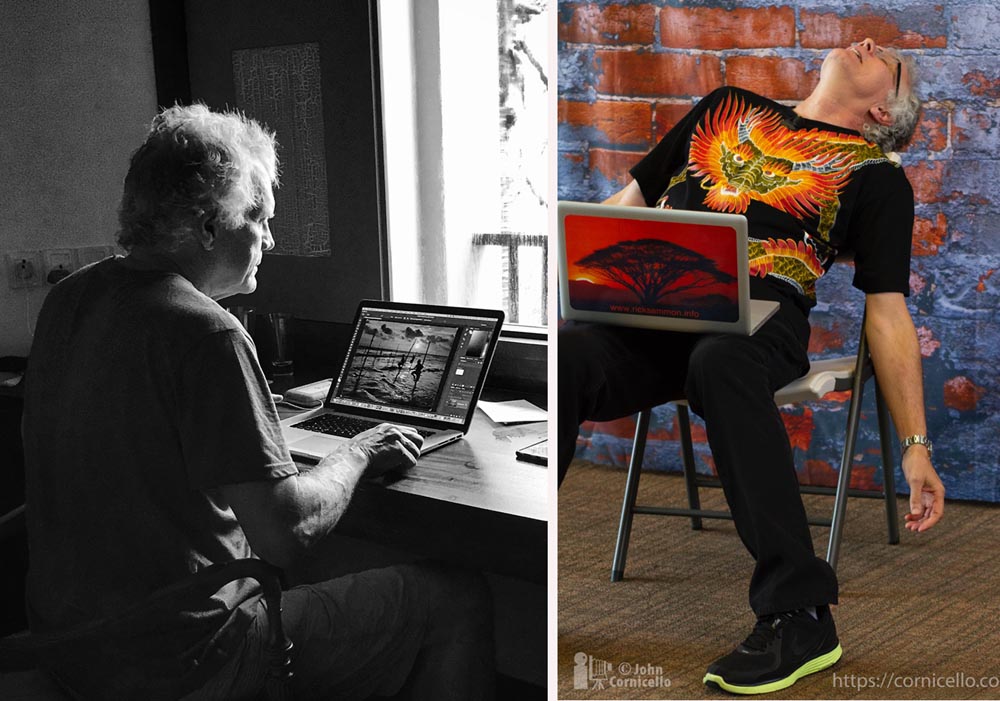
First, I’d like to thank Scott and Brad for having me back on Photoshop Insider. It’s always an honor – and a lot of fun to be here! Second, I’d like to thank YOU for stopping by today. Third, whew! I feel much better getting 40 books out of my head!!
So here’s the deal: A new filter, camera, lens, tripod and speedlite can surely help you make better photographs – but they can’t necessarily make you a better photographer.
That’s where my 40th book, Photo Therapy Motivation and Wisdom – Discovering the power of pictures, comes in. Understanding why and how we are motivated to make pictures – and what your photography means to you – is of the utmost importance. So is learning about emotional intelligence for photographers, how to steal like an artist, realizing that it’s never to late to be who you might have been, and understanding the difference between looking at seeing. Exploring light and color therapy also helps.
All those topics and much more – including my 40 quick-tip “Sammonisms” and 20 “missions” (self assignments) – are covered in my latest book.

Click here to order the paperback version ($15.99).
Unlike my other 39 photo-rich books, Photo Therapy Motivation and Wisdom – Discovering the power of pictures has no photographs between the covers. Yet, I feel as though it is my most important work. I trust this book will make you think – hard – about your photography, and about how using your brain, the best photo “accessory,” will help you become a better photographer. Or as stated by black-and-white landscape photographer Ansel Adams, “The single most important component of a camera is the twelve inches behind it.”
Famed photographer Lewis Hien said, “If I could say in words what I say with my pictures, I would not have to lug around a camera.”
It’s not that I am tired of lugging around a camera. It’s just that I think the motivational and inspirational message of this book is better expressed without showing my own pictures. Rather, in reading the 35,000-word text, I’d like you to imagine your own pictures – and potential pictures – while I am describing a situation, process, technique, feeling or emotion.
Well-known photo educators, who also believe in the power photo therapy, contributed to my latest work. They include: Art Wolfe, Trey Ratcliff, Scott Bourne, Skip Cohen, Richard Bernabe, Randy Hanna, Ron Clifford, Denise Ippolito, Derrick Story, Jonathan Scott (The Big Cat Man), and Steve Brazill.

Before I get going here, this is how I looked while writing 35K words… and after!
Here are a few chapter excerpts from the text-only book. Enjoy!
Chapter 3: Photography Can Improve Your Health and Sense of Wellbeing
If you are seeking creative ideas, go out walking. Angles whisper to a man who goes for a walk.
Raymond Inmon
Photography, for the most part, involves exercise – walking around a bustling city, hiking a wooded trail, hiking up a mountain path, making footprints on a sandy beach and so on.
Those activities can help us burn calories and build muscles – if we walk as if we are going somewhere, as opposed to just strolling along. Add a camera backpack filled with gear, a tripod and a bottle of water, and that extra weight causes us to exercise a bit more strenuously which can be a good thing if we want to keep in shape.
Exercising can actually change our DNA for the better, as outlined in a December 17, 2014 article How Exercise Can Change our DNA in the New York Times by Gretchen Reynolds. Toward the end of the article we find this quote by Malene Lindholm, a graduate student at the Karolinska Institute, who led the study: “Through endurance training, a lifestyle change that is easily available for most people and doesn’t cost much money,” Ms. Lindholm said, “we can induce changes that affect how we use our genes and, through that, get healthier and more functional muscles that ultimately improve our quality of life.”
Chapter 6: Creating Your Own Reality
Reality leaves a lot to the imagination.
John Lennon
I have a presentation (as well as a book) called Creative Visualization for Photographers. The idea of the presentation is that we need to visualize the end result before we take a picture. We need to envision how a three-dimensional scene will look as a two-dimensional image, how light will be captured by our cameras, which is different than how our eyes see light – highlights and shadows. We also need to think about capturing the colors in a scene.
We need to think about what we want to include in the frame by subtracting elements in the scene – either by careful composition or by cropping in the digital darkroom. That process, by the way, is the opposite of what an artist does when creating a painting: a painter adds elements to a canvas. Therefore, photography is a subtractive process while painting is an additive process.
Speaking of being subtractive, think about this – for a while: a photograph hides more than it reveals. For example, a photograph can hide what we don’t want to see in a scene, and reveals only what we want to see in a scene. After spending a lifetime behind the lens, I can say that is true.
Getting back to creative visualization, we need to think about creating a mood or feeling. It’s the same with a pop song or classical musical score, is paramount.
Chapter 7: Looking vs. Seeing
A photograph is usually looked at – and seldom looked into.
Ansel Adams
Yes, this book is about photography, but I’d like to share some thoughts here on being a musician before I get to the difference between seeing and looking. Please bear with me. This will all make good sense.
For musicians, there is a big different between hearing and listening. For example, if a musician is driving around in a car with the radio on while having a serious conservation with a friend, he may not be listening to all the subtleties of a song – how the bass is complementing the drums, how the singer is phrasing the words, how a soloist is leaving space between the notes and so on. He is just hearing.
On the other hand, if a musician is driving around alone with the radio on, and is interested in a song, he is listening and not simply hearing. Most important, there is joy in listening because he appreciates the arrangement, skill of the musicians and production of the song.
The analogy to photography is simple: there is a big different between looking and seeing.
A non-photographer sees a scene, but may not appreciate all the subtle details, especially in the shadow and highlight areas. And a non-photographer may see at a portrait, perhaps one by Yousuf Karsh (1908-2002), and not appreciate the hours and hours of work that went into the lighting and processing of the photograph.
A photographer, on the other hand, looks at all the details in scene, and appreciates how our eyes and our cameras capture shadows and highlights, contrast, colors and details. The photographer would also appreciate, maybe even marvel at, the Karsh of Ottawa (as he was also known) black-and-white portrait of Ernest Hemmingway – which seems to glow from within.
Chapter 8: Learning is Health
Learning is health.
Buddhist proverb
Learning a new skill like photography, or learning how to improve a current skill, has many benefits. Looking inward, learning adds some fun and satisfaction to our lives. It can also fight off boredom and improve memory. Looking outward, learning can make us a more interesting and fun person, because we have more to share.
And get this about learning, according to an article on the CCSU (Central Connecticut State University) web site: “The white matter in your brain is called myelin, and it helps improve performance on a number of tasks. The more people practice a new skill, the denser the myelin in their brains becomes, which helps them learn even better.”
With all this in mind, if you are serious about your craft or hobby, it makes sense that the more you take pictures, the better and faster you will become a good photographer – and that can lead to being a happier and healthier person.
Chapter 18: Light Therapy, Color Therapy and Color Blindness
Photography in color? It is something indigestible, the negation of all photography’s three-dimensional values.
Henri Cartier-Bresson
As I was thinking about and researching photo therapy for this book, I was reminded of the color therapy I was given by a chiropractor while I was being treated for my crippling back pain. The therapy involved being in a room as different colors were displayed on the walls.
I was also reminded about how much I, my wife and many of the people I know, are affected by sunny versus dark days, and how the difference in light affects our mood.
With that in mind, I thought I would add this chapter to this book, because an understanding of light and color affects our photography and plays a role in photo therapy.
Photography is about light – all about light. The word photography, in fact, steams from the Greek words that basically mean light and drawing. Combine, they mean drawing with light.
No light, no photograph. It’s the magic of seeing and then recording light, and the different colors in the light spectrum, that enables us to relive and share a memory again and again with our neighbor or with strangers around the world.
Photo therapy, therefore, would not exist without light and color, which actually have their own forms of therapy. It’s interesting and beneficial to take a look at these forms of therapy because light and color affect our mood. It’s the mood and feeling of a photograph that are of the utmost importance, much more so than what f-stop or camera that one uses.
Chapter 20: My 40 Sammonisms and All Quotes
Sometimes I wish my first word was ‘quote,’ so on my death bed I could say ‘end quote.’
Steven Wright
As you can tell from reading the opening of every chapter in this book, I am big on quotes – because I feel a quote drives home a concept in a few concise words.
The text of this chapter begins with what some photographers call my “Sammonisms.” These are short sayings that, like quotes, convey an idea quickly and easily. No photos needed. Some are not my original sayings. I’ve heard them in one place or another over the years, and have adopted them to share with my students and readers – with the goal of encouraging them to make better images.
The second part of this chapter includes the famous quotes in this book. I’ve put them all together for quick and easy inspiration and motivation.
Here are those Sammonisms, 40 of them, along with brief explanations.
1 The name of the game is to fill the frame. Want to make an image with impact? Fill the frame with the subject. Of course, there is something to be said about using negative space in a frame.
40 Don’t delete. If you get an out-of-focus picture, don’t delete it! One out-of-focus picture is a mistake; 20 out-of-focus pictures is a style.
Okay, it’s time for the quotes in this book.
If I could tell the story in words, I wouldn’t need to lug around a camera.
Lewis Hine
You don’t drown by falling in water. You only drown if you stay there.
Zig Zigler
Learn from yesterday, live for today and hope for tomorrow. The important thing is not to stop questioning.
Albert Einstein
I think everything in life is art. What you do. How you dress. The way you love someone and how you talk. Your smile and your personality. What you believe in, and all your dreams. Life is art.
If you are seeking creative ideas, go out walking. Angles whisper to a man who goes for a walk.
Raymond Inmon
Everything you see exists together in a delicate balance. As king, you need to understand that balance and respect all the creatures, from the crawling ant to the leaping antelope.
Mufasa, Disney’s Lion King
Reality leaves a lot to the imagination.
John Lennon
Rick Sammon has 17 classes on KelbyOne. All of them include photographs. ☺




